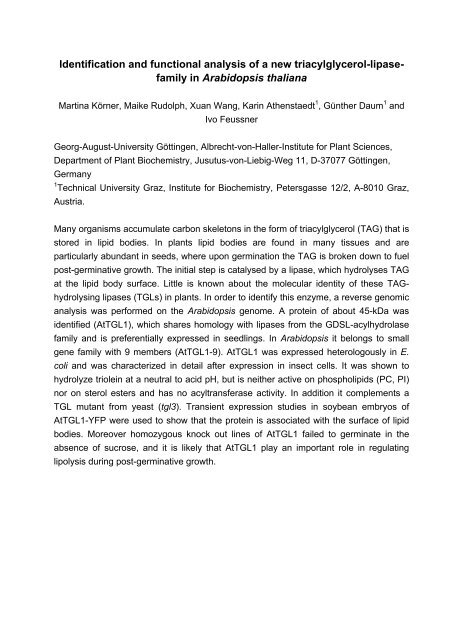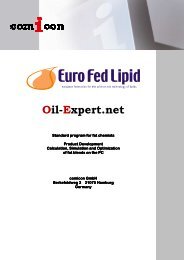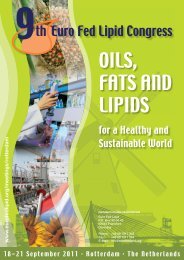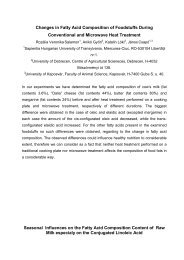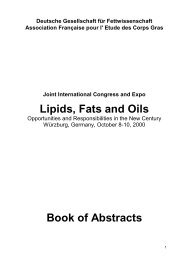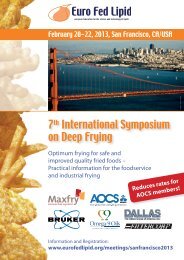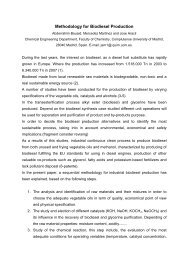Abstracts now available online - Euro Fed Lipid
Abstracts now available online - Euro Fed Lipid
Abstracts now available online - Euro Fed Lipid
Create successful ePaper yourself
Turn your PDF publications into a flip-book with our unique Google optimized e-Paper software.
Identification and functional analysis of a new triacylglycerol-lipasefamily<br />
in Arabidopsis thaliana<br />
Martina Körner, Maike Rudolph, Xuan Wang, Karin Athenstaedt 1 , Günther Daum 1 and<br />
Ivo Feussner<br />
Georg-August-University Göttingen, Albrecht-von-Haller-Institute for Plant Sciences,<br />
Department of Plant Biochemistry, Jusutus-von-Liebig-Weg 11, D-37077 Göttingen,<br />
Germany<br />
1<br />
Technical University Graz, Institute for Biochemistry, Petersgasse 12/2, A-8010 Graz,<br />
Austria.<br />
Many organisms accumulate carbon skeletons in the form of triacylglycerol (TAG) that is<br />
stored in lipid bodies. In plants lipid bodies are found in many tissues and are<br />
particularly abundant in seeds, where upon germination the TAG is broken down to fuel<br />
post-germinative growth. The initial step is catalysed by a lipase, which hydrolyses TAG<br />
at the lipid body surface. Little is k<strong>now</strong>n about the molecular identity of these TAGhydrolysing<br />
lipases (TGLs) in plants. In order to identify this enzyme, a reverse genomic<br />
analysis was performed on the Arabidopsis genome. A protein of about 45-kDa was<br />
identified (AtTGL1), which shares homology with lipases from the GDSL-acylhydrolase<br />
family and is preferentially expressed in seedlings. In Arabidopsis it belongs to small<br />
gene family with 9 members (AtTGL1-9). AtTGL1 was expressed heterologously in E.<br />
coli and was characterized in detail after expression in insect cells. It was shown to<br />
hydrolyze triolein at a neutral to acid pH, but is neither active on phospholipids (PC, PI)<br />
nor on sterol esters and has no acyltransferase activity. In addition it complements a<br />
TGL mutant from yeast (tgl3). Transient expression studies in soybean embryos of<br />
AtTGL1-YFP were used to show that the protein is associated with the surface of lipid<br />
bodies. Moreover homozygous knock out lines of AtTGL1 failed to germinate in the<br />
absence of sucrose, and it is likely that AtTGL1 play an important role in regulating<br />
lipolysis during post-germinative growth.


